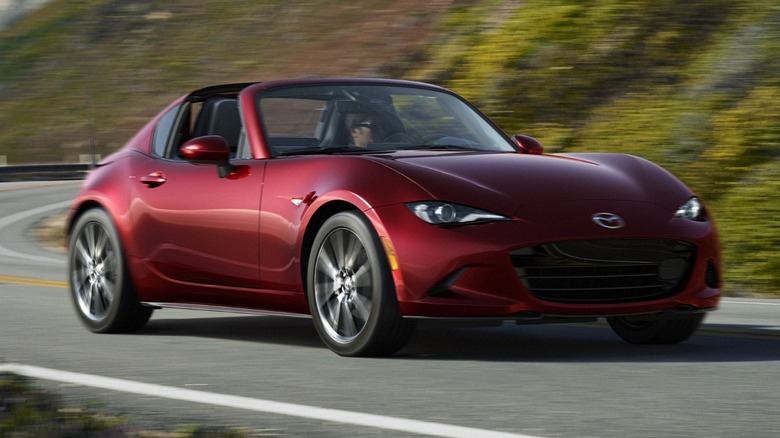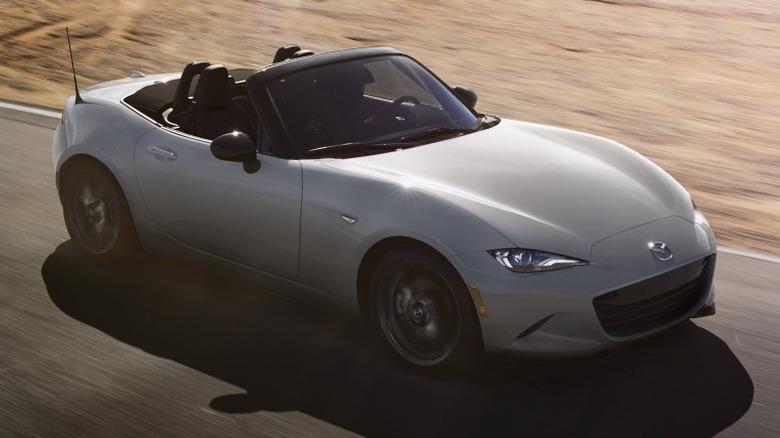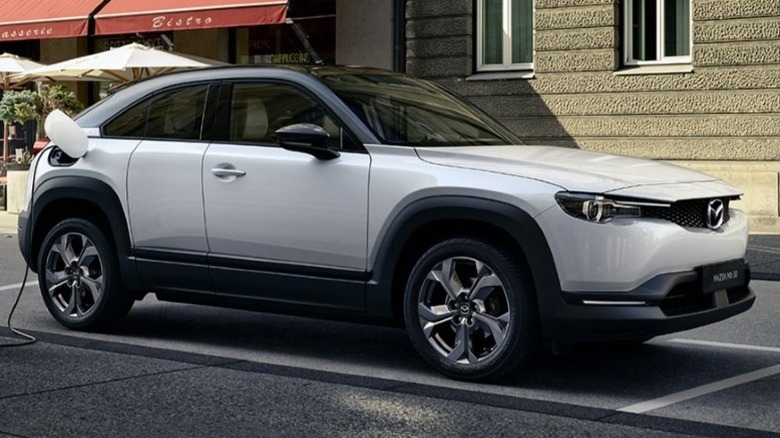What Does MX Stand For On Mazda Cars?
Japanese automaker Mazda has an uncanny knack of making highly refined, generously equipped, and almost luxurious cars with engaging handling. In its 100-plus years of existence, the carmaker has brought out numerous cars with many different names denoted by a series of letters and numbers with many different meanings. There have been designations such as Mazda Luce R130, R360, or RX-7, which stands for Rotary eXperiment or eXperiment 7. As you would have imagined, the rotary bit is associated with the car's use of Mazda's iconic rotary engine, which is known for its smooth power delivery.
There's also the CX moniker used on Mazda models such as the CX-30, CX-5, CX-50, CX-70, and CX-90 models to indicate that they are "crossover" SUVs. As for the MX name, it stands for Mazda Experimental. Although the MX badge owes its popularity to the Mazda MX-5 Miata, its debut stretches back to 1981 with the introduction of the wedge-shaped Mazda MX-81 Aria concept car developed by Turin-based coachbuilder Bertone. In 1983, Mazda launched the rear-wheel steering-bearing MX-02 concept car as a follow-up to the Mazda MX-81 Aria, and several other cars have featured the MX designation in their names since. These include the MX-03 concept, MX-04 concept, MX-3, MX-6, MXR-01 prototype race car, MX-Sport Tourer concept, MX-Flexa, MX-Sport Runabout concept, MX-Sportif, MX-MicroSport, MX-MicroSport, MX-Crossport, and MX-30.
The Mazda MX-5 Miata was the first mainstream production car to bear Mazda's MX badge
Its lightweight build quality, lithe handling, and sales success mean the universally admired MX-5 Miata is the biggest Mazda MX story yet. But the sports car had already earned its place in the history books right from its debut in 1989 by becoming Mazda's first MX-badged production car. The original MX-5 Miata was produced through 1997, with earlier examples featuring a 1.6-liter straight-four engine producing 116 horsepower and 100 lb-ft of torque. The engine's displacement grew to 1.8 liters in 1994, yielding a 10 percent power increase to 128 hp. In 1996, the Miata got a bit more power, with output rising to 133 horses.
After launching in 1997, the second-generation MX-5 Miata arrived on dealership lots in 1998 ahead of the 1999 model year with a 7 hp power bump that raised output to 140 horsepower. Fast-forward to 2001, and the MX-5 Miata received a 15-hp power hike with Mazda's addition of variable intake-valve timing technology. With 155 hp and 125 lb-ft on tap, the NB2 MX-5 Miata is claimed to sprint from zero to 60 mph in 8.1 seconds on its way to a limited top speed of 121 mph.
Later in 2004, Mazda's performance division, Mazdaspeed fitted the engine with a turbocharger (and made several other changes) to create the Mazdaspeed MX-5, which upped power further to 178 horses and 166 lb-ft while also improving the 0-60 time to 6.7 seconds.
For its third generation, which debuted in 2005, the MX-5 Miata used a new platform and 2.0-liter four-cylinder engine with 170 hp and 140 lb-ft. Meanwhile, the current fourth-generation Mazda MX-5 Miata has since taken things up a notch, with up to 181 hp and 151 lb-ft at the ready.
The Mazda MX-30 is Mazda's first electric vehicle
The MX-81 and MX-5 Miata aren't the only Mazda MX models to set records. In 2020, the Mazda MX-30 made history when it began production at the brand's Ujina factory, as it became the first all-electric production vehicle to come from the Japanese automaker. The subcompact crossover SUV uses a single motor on the front axle motivated by a 35.5-kWh lithium-ion battery to generate 143 horsepower and 200 lb-ft of torque. With that battery pack, the MX-30 can travel an EPA-estimated range of 100 miles on a charge.
Mazda says it should take between around minutes to charge the crossover SUV to 80% at a DC rapid charger. And as for fuel economy, the EPA cites 98 MPGe (miles per gallon of gasoline-equivalent) in the city, 85 MPGe on the highway, and 92 MPGe in combined city-highway use. Sadly, the Mazda MX-30 EV's stint on the U.S. market didn't last very long, as it was discontinued in 2023 after its second model year due to Mazda's decision to ramp up production of bigger hybrid and plug-in hybrid models such as the CX-50 Hybrid, CX-90 PHEV, and CX-70 PHEV.


